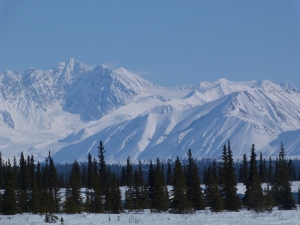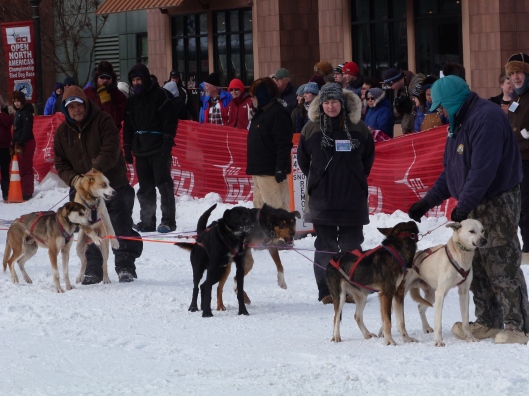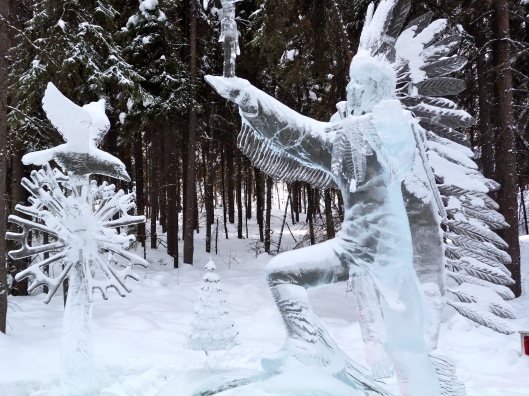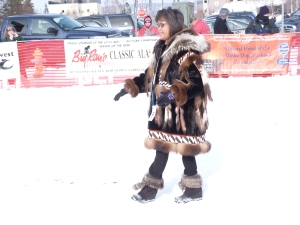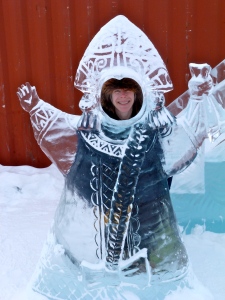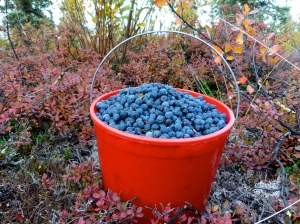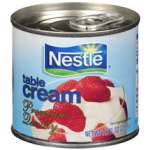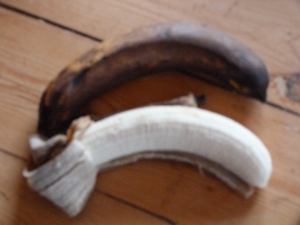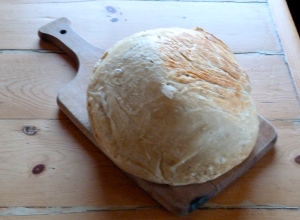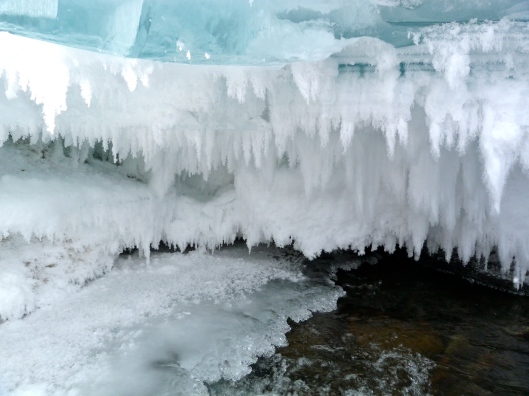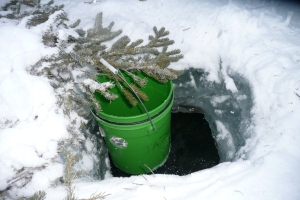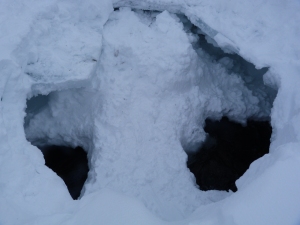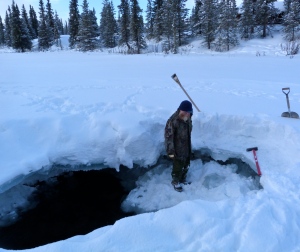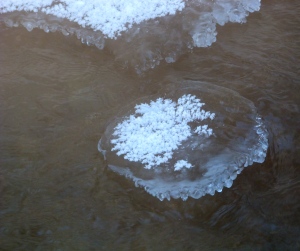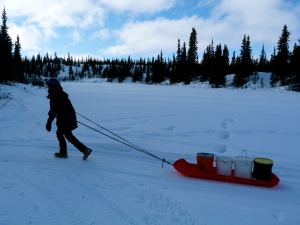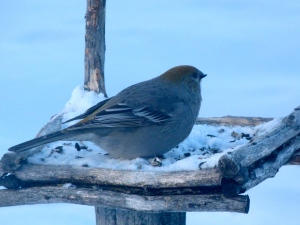Sunny days, sunglasses and sunscreen: it must be spring break! Snow and sun combine to make the world bright white and blue; even the green of the trees fades into the background. Days stretch to evening, long as mid-summer days in San Francisco. I never need a flashlight when the snows are lit with the reflection of the moon and stars; if I did, it would blind me to the green glow of auroras that followed the recent spate of solar flares. No wonder Alaskans find this the perfect place for spring break. Just as a torrent of snowmachiners rushed down our highway, over our river and through our woods, we took our own spring break and headed north to Fairbanks.
The impetus for our trip was a three-day conference on sustainable agriculture in Alaska. But it was also a chance to buy groceries and do laundry after nearly three months in the backwoods. We stayed with Gary’s sister Tina and her family in North Pole; I even got my first haircut in eight months, thanks to Gary’s niece Selena!
North Pole is the town that gets and answers all the letters sent to “Santa Claus, North Pole.” It’s a place where keeping Christmas decorations up year-round is encouraged, especially around Santa Claus Lane (which intersects with St. Nicolas Drive). It earns its name in part by having weather that is easily 15 degrees colder than nearby Fairbanks, which is itself as cold as or colder than we are in winter. But we got lucky—it never got below -30° when we were there.
And there’s lots going on in Fairbanks this time of year: we saw the third and final day of the Open North American Championship sled dog race, noisy dogs bouncing with excitement, a parka parade showing off traditional parkas (and, with nine entrants, reminding us that Fairbanks is still a small town), an ice sculpture park, and the Museum of the North at the University of Alaska.
It’s always hard to leave home, in part because it robs us of so many good days here. It takes the better part of two days to get ready for the trip, two days of travel round trip, and a day to unpack and resettle. Getting ready includes gathering laundry, packing and cleaning, but we also have to prepare for the cabin to freeze. Gary makes large batches of kindling, enough to start and keep a quick, hot fire burning for the several hours it takes to warm the cabin and everything in it when we return. I take charge of dealing with food and water. It’s getting easier: this time we didn’t have any fresh food left, eliminating the chore of blanching it or otherwise preparing it so it would survive freezing. Last time we went away I made ice in small batches in pans to thaw quickly when we returned, so we wouldn’t have to get water from the river after a long day’s travel. It was tedious, since only a tiny bit of water could be left in each pan or bucket; allowing water to freeze in any volume will cause the containers to bulge and buckle. This time I harvested ice and icicles from my water hole and stored them in buckets. At first I chiseled ice, which I needed to do anyway to re-open the iced-over water hole. When most of the ice dropped into the current as it broke free, I hit on the idea of filling my buckets with icicles. I hated to do it—I love seeing the icicles in my beautiful ice room—but by taking them from the least visible spots I was able to keep the beauty of the place intact. (See http://www.indeep-alaska.com/2011/12/03/Riverdance/)
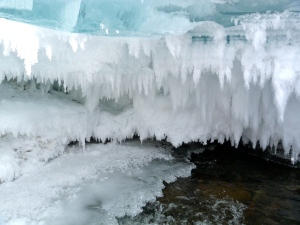 We went to the conference to hear what’s going on in agriculture in Alaska, which ships in 95% of its food supply. We learned about mushroom cultivation; flour milling; cold-hardy hogs that eat grass and don’t root; beekeeping in top-bar hives; geothermal farming done near hot springs; why peony farming is such a specialty here; how to get the government to pay for your greenhouse; biochar, an environmentally constructive charred-wood product used for long-term soil improvement; and how to sell at farmers markets and to restaurants and buyers for Princess, the big hotel and cruise line.
We went to the conference to hear what’s going on in agriculture in Alaska, which ships in 95% of its food supply. We learned about mushroom cultivation; flour milling; cold-hardy hogs that eat grass and don’t root; beekeeping in top-bar hives; geothermal farming done near hot springs; why peony farming is such a specialty here; how to get the government to pay for your greenhouse; biochar, an environmentally constructive charred-wood product used for long-term soil improvement; and how to sell at farmers markets and to restaurants and buyers for Princess, the big hotel and cruise line.
Living here is amazing, but it’s hard to generate much income. We’d like to have land where we can grow our own food and keep horses and livestock for work, play, meat, and maybe dairy. Our growing season is short here and the land won’t support much more than one or two goats or sheep (or reindeer or yaks) and six weeks of garden vegetables. We’ll need more land in a less remote, more temperate place. That doesn’t rule out Alaska, but it almost certainly rules out our home here, which sees snow early and late, and is likely to have a freeze every month of the year.
Gary has some experience working with cattle and sheep. I am bereft of experience even vaguely relevant to ranching. Some days I think about finding some docile, high-butterfat sort of animal for a varietal butter or artisanal ice cream endeavor. Having just left the regulation-intensive industry of money management, I question the wisdom of getting into anything as highly regulated as dairy. When I think about the ice cream itself, the regulations don’t loom so large. Then I remember I know nothing about milking animals, except that it must be done every day twice a day, except in winter when I could let the poor gals dry up. So my thoughts turn to sheep or mushrooms or biochar or ecotourism. But eventually I return to dreams of butter, cheese and ice cream: if I can’t sell it, at least I can eat it!
Pooling our resources, Gary and I hope to find land—land in need of improvement, perhaps, but enough for a few grazing animals—land enough to embark on our experiment without taking on debt or spending all our savings. We want natural beauty, live water, room to roam. If the land is fenced for cattle, with a house and maybe a barn, that would save precious time, but we could live in a tent or a yurt at first if we had to. We love a sense of seclusion, but community is important too, and not just to have a market for our products. Where we might do this—in Alaska or in the lower 48—is, like everything else about our plan, very much unsettled.
I’m in no rush. I should be, I suppose, as we are rather well above a prudent age for embarking on such a different and demanding venture. I’m just not ready to leave. I don’t want to think I’ll never have another winter and spring here. April, Gary tells me, is perhaps the most beautiful month of all. I suppose everything will come together in its own time. We’ll find land that seems right, and it may tell us what to do. Then we’ll start our new adventure. Meanwhile I’ll revel in this one, knowing it won’t last forever.
Sunrise: 7:36 a.m.
Sunset: 8:27 p.m.
Weather: High 17°, low -23°, calm, mixed sun and clouds.

